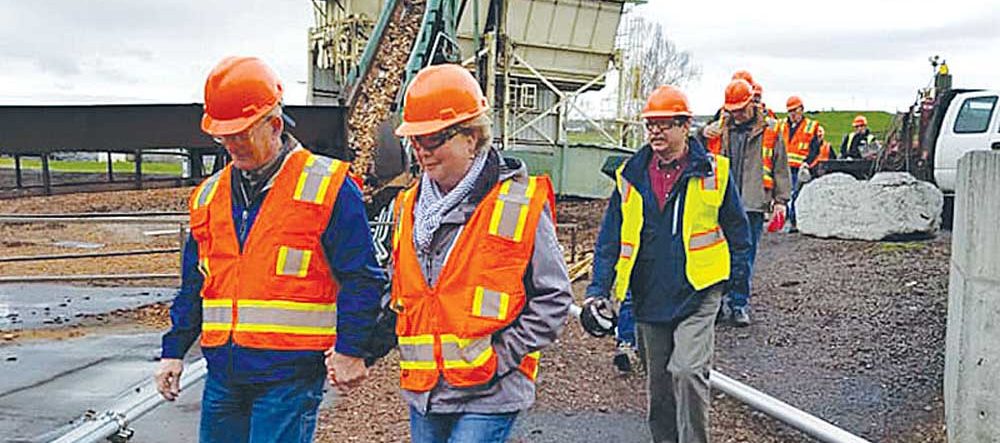A new era: Northwest wheat organizations get new leaders
Published 7:00 am Thursday, January 5, 2023

- Idaho Grain Producers Association past president Jamie Kress, Idaho Wheat Commission board member Cory Kress and Idaho Wheat Commission executive director Britany Hurst Marchant meet with Joe Bippert, U.S. Wheat Associates assistant regional director for South Asia, and Joe Sowers, regional vice president for South and Southeast Asia at U.S. Wheat's office in Singapore.
It’s a new era of leadership at the three Pacific Northwest wheat commissions.
Each of them has new top executives.
Amanda Hoey took over as Oregon Wheat’s CEO in January 2020, overseeing the Oregon Wheat Commission and Oregon Wheat Growers League. She replaced Blake Rowe, who held the position for eight years.
Casey Chumrau replaced Glen Squires as chief executive officer of the Washington Grain Commission in 2022. Squires held the position for 10 years.
Previously, Chumrau was executive director of the Idaho Wheat Commission for two years, replacing Blaine Jacobson, who held the position for 18 years.
Britany Hurst Marchant replaced Chumrau as executive director of the Idaho commission last September.
“It’s exciting times for the industry,” said Nicole Berg, president of the National Association of Wheat Growers and a Paterson, Wash., farmer. “We have had some great leaders in the past, but now we have some leaders coming in with fresh eyes. I look forward to the huge opportunities they can create for the industry.”
The three wheat leaders spoke with the Capital Press during an online roundtable discussion on Oct. 21. The interview has been edited for clarity and length.
Q. What are the strengths of the Pacific Northwest wheat industry?
Marchant: One of the biggest strengths is our transportation infrastructure. We are able to quickly and easily get wheat to port down the river.
Hoey: There are two others I would add in. Our producers — the innovation and the leadership we have within the Pacific Northwest is unrivaled. The three (commissions) in the Pacific Northwest have worked together as a tri-state collaborative. I think that’s a really unique relationship, with the longevity and the foresight our producers have had to combine together, recognizing that as we are looking at those markets, we are one Pacific Northwest as a whole. The logistics then give us that access to some really sophisticated markets.
The third one being our long-term focus on increasing quality, the dollars we put into research, grower communication — that has put the region’s wheat industry definitely a step above on a global scale.
Chumrau: You’re kind of seeing the collaboration here today. The three states have a very long history of working together. That really strengthens our position in the market and has really been beneficial over the years.
We have excellent relationships with our customers. We have 50, 60, 70 years building those relationships. We have incredible information exchange programs with our customers that help us improve our wheat varieties so they better fit the needs of those customers. We have really consistent production. We have focused on end-quality for decades.
In addition to that higher functionality of the wheat and flour, we have a lower-moisture product and cleaner crops coming out of this region than some of the other regions and suppliers around the world. That just creates higher value for our customers.
Marchant: Part of the longevity of those relationships with customers is because we are able to produce consistent, quality production. But also, we’re able to deliver with consistency that they can count on, to receive the wheat product in a timely manner. Partly because we have access to a river system that allows us to get that product to market in a timely and consistent way.
Hoey: There’s a reason that you highlight that. In all the instability we’ve faced in the last couple years, that’s something we’ve been able to deliver, not just on the U.S. scale, but specifically for the Pacific Northwest. That is a unique aspect of the systems we’ve built, on the regulatory front and the infrastructure side.
Q. What needs work?
Chumrau: We need to do a better job of sharing our story. The pandemic really exposed some of the logistics and transportation that we take for granted.
As people have moved farther away from the farm, they don’t understand how their food is produced and how it gets to market.
We’re doing a lot of great things. The farmers are very sophisticated, they are technologically advanced, they’re excellent stewards of the land. … Farmers are very good at putting their head down and getting to work, but sometimes we need to look up and share that story as well.
Marchant: More and more consumers also want to know where their food is coming from. There’s a large movement in that direction, to know exactly what is in their food and where it has come from.
We’re the ones that need to let them know that, that growers raised wheat in an environmentally conscious, sustainable way, that they are good stewards of the land, but also that the product they’re getting is coming from family farms.
Hoey: The reasons the commission was formed, in relation to market access, our grower education and research and development, those continue to maintain in the work that we do.
On the research side, we’re not going to see any changes in our land and acreage. And so our capacity to increase production, both for support of our producers and the thin margins they are operating on, but also to meet global demand on food production.
That research and technology, the work we’re doing on the PNW side on new varieties, to support on addressing pest, weed and disease pressures, those will all continue to maintain the work we’re doing.
I don’t see a wholesale shift in that, probably individual variations within the work we’re doing, but maintaining on those three core will be our focus. Continual reinvestments, including in the river system.
Q: What are your short-term priorities?
Chumrau: To reconnect with our customers in person. We had over two years where we were not able to meet our customers face-to-face, and we got back to a really good start this summer. There were over 20 trade teams that visited the region and now being able to get back overseas ourselves and meet them in their mills and plants, and hear what the customers are needing from us, is an important priority.
Marchant: Just building on the collaboration we already have in the PNW, but making that stronger. Exploring more opportunities to create avenues that we can strengthen each other.
Q: What are the long-term goals?
Hoey: Keeping wheat in business, that is my long-term priority, the focus on our producers. I feel a strong obligation and responsibility for that, in all the work that we do.
Change how we communicate the work we are doing as we see that shift in population from rural to urban. It really only takes one generation away from the farm to lose some of that connection. …
Urban consumers really want to have and feel a good connection to farm and field. We need to do a better job of supporting our producers and helping consumers understand the practices we’re using on the farm and the fact that the United States and the Pacific Northwest are extremely sustainable in the practices we’re using.
All the work we’re doing is supporting the current and next generation coming into farm production, and ensuring they can be successful, as we have been for three generations prior.
Chumrau: We need to move toward marketing our PNW wheat as an ingredient, as opposed to a commodity. We rarely compete on price, so we really have to differentiate our wheat on quality.
To do that, we need to continue improving our end-use quality and functionality of the wheat varieties we are breeding, while also maintaining the yield and agronomic factors that are important to farmers.
Marchant: We can’t just keep doing what we’ve always done. In the future, we’re going to have to continue to innovate, use research and technology advancements to produce more wheat to feed a growing population with less land, fewer resources.
Already over the past several decades, that’s what our farmers have been doing. They’ve been staying up to date on those advancements so they can be profitable and they can continue to produce more with less.
In that way, we are going to do what we’ve always done, which is to grow along with the advancements in technology.
Q: What’s on your wish list?
Hoey: Definitely reinvestment in the infrastructure that allows us to deliver wheat to market.
Stability for our producers. Top of mind right now is the cost of input prices, the ability to source material and get that timely.
Increasing our exports and sustainining and maintaining wheat prices.
Getting a farm bill passed that has elements related to risk mitigation, expansion of the Market Access Program and Foreign Market Development program.
Marchant: I would like to see better communication, so that the consumer understands what we do and how we do it. Trust the process and the product.
Chumrau: I would love to see more growers involved in leadership. We would love to have more feedback from growers on what they need from the commission.
I think a lot of times growers think they just know how to farm and who’s going to want their opinion? But they are the ones on the ground every single day and know what the challenges are and where we should be going and what we should be pushing for legislatively and in society.
I would love to see a bigger focus on mental health and the well-being of farmers. That’s an issue in general, but especially in the farm and agricultural community. If we could learn to talk about that a little bit more openly, it would be really beneficial to our industry.
Q: Is there something farmers should have on their radar that they’re not thinking about right now?
Hoey: There’s very little that’s not on the radar of our producers, they’re the ones out innovating in the field, dealing with the issues day-to-day. They’re always the ones calling me to be aware of what should be on our radar. They’ve done that from the farm field end all the way up to the policy end.
I don’t think there’s anything that’s not on the radar, it’s probably more, “How do we address the challenges and work with our producers to help navigate the waters we have coming up?”
Q. How will wheat farming look different in the next 25 to 50 years?
Hoey: I see the trends of continuation of population growth, combined with a whole new generation of farmers. Farming won’t get any easier, so we won’t reduce those challenges on thin profit margins.
Those things I think combine to further increase the mechanization within our farming practices, to provide more focus on precision agriculture and really increase some of the complexity of the data our farmers are already beginning to use to make decisions on the farm, in relation to soil, input and water management. The biggest change is acceleration of a trend that is already here and in place. …
Marchant: Farming is one of the most high-tech industries. As we grow into bigger populations, less land that’s available, we are going to have to do more with less.We will see a definite acceleration in mechanization, innovation and technology. And farming operations that keep up with that and are on the cutting-edge.
Chumrau: I think consumers are going to drive a lot of the change in our industry in the next 25 to 50 years. For example, will those markets accept biotechnology? Will they accept new forms of weed management and those kinds of things we’re looking at right now, because we see short-term and long-term challenges?
Q: Any specific challenges you want to spotlight?
Chumrau: High input costs are on the forefront of everybody’s mind right now. That’s been a trend over the last year and we don’t see any relief right now.
Marchant: Market volatility. Prices that are all over the place, depending on the news out of the Black Sea region.
Hoey: We’ve been in a place where those higher wheat prices have helped, to a degree, to offset some of the high input prices. We’ve seen doubling and tripling on fuel and fertilizer prices and all the things required to plant and maintain a healthy wheat crop.
If those high input prices continue but if the price of wheat moves lower, the ability to operate in that environment and higher borrowing costs will make it even more challenging for producers.
We’ve had an ability with higher wheat prices to manage through the last couple of years, but that will be a challenge as we move forward, and a really concerning one.
Age: 40
Hometown: The Dalles, Ore.
Current location: The Dalles, Ore.
Education: Bachelor’s degree in economics, Whitman College
Family: Husband Ben, lives on the farm with extended family
Farming background: Family has a dryland wheat farm
Hobbies: Running and gardening
Website: https://www.owgl.org/
Age: 39
Hometown: Heyburn, Idaho
Current location: Firth, Idaho
Education: Bachelor’s degree in history and political science, Boise State University
Family: Husband Luke, two stepsons
Farming background: “I grew up in rural Idaho.”
Hobbies: Running, anything outside, travel, reading. “I worship the sun.”
Website: https://www.idahowheat.org/
Age: 39
Hometown: Missoula, Mont.
Current location: Spokane
Education: bachelor degree in history, University of Oregon; master’s degree in business administration, University of Montana
Family: Husband Valentin, dog Canela
Farming background: Aunt and uncle have a wheat farm
Hobbies: Hiking, traveling, reading and eating
Website: https://wagrains.org/
For an extended version of the interview go to www.capitalpress.com.








